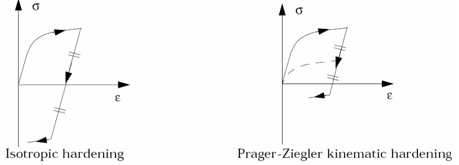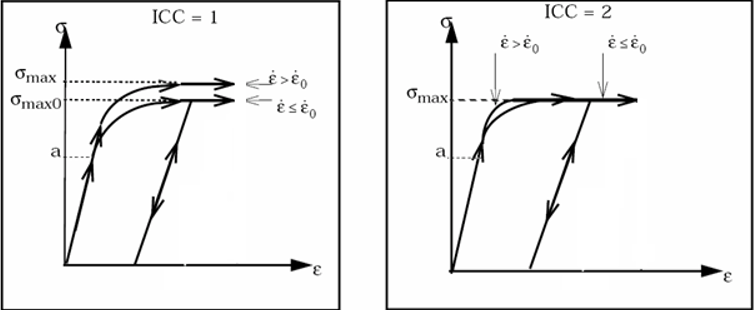/MAT/LAW44 (COWPER)
Block Format Keyword The Cowper-Symonds law models an elasto-plastic material. The basic principle is the same as the standard Johnson-Cook model; the only difference between the two laws lies in the expression for strain rate effect on flow stress.
Format
| (1) | (2) | (3) | (4) | (5) | (6) | (7) | (8) | (9) | (10) |
|---|---|---|---|---|---|---|---|---|---|
| /MAT/LAW44/mat_ID/unit_ID or /MAT/COWPER/mat_ID/unit_ID | |||||||||
| mat_title | |||||||||
| E | |||||||||
| a | b | n | Chard | ||||||
| c | p | ICC | Fsmooth | Fcut | |||||
Definitions
| Field | Contents | SI Unit Example |
|---|---|---|
| mat_ID | Material
identifier (Integer, maximum 10 digits) |
|
| unit_ID | Unit Identifier (Integer, maximum 10 digits) |
|
| mat_title | Material
title (Character, maximum 100 characters) |
|
| Initial
density (Real) |
||
| E | Young's
modulus (Real) |
|
| Poisson's
ratio (Real) |
||
| a | Plasticity yield
stress (Real) |
|
| b | Plasticity
hardening parameter (Real) |
|
| n | Plasticity
hardening exponent Default = 1.0 (Real) |
|
| Chard | Plasticity
Iso-kinematic hardening factor.
Default = 0.0 (Real) |
|
| Plasticity maximum
stress Default = 1030 (Real) |
||
| c | Strain rate coefficient.
(Real) |
|
| p | Strain rate
exponent. Default = 1.0 (Real) |
|
| ICC | Strain rate
computation flag. 6
(Integer) |
|
| Fsmooth | Smooth strain rate
option flag.
(Integer) |
|
| Fcut | Cutoff frequency
for strain rate filtering. Default = 1030 (Real) |
|
| Failure plastic
strain. Default = 1030 (Real) |
||
| Tensile failure
strain 1. Default = 1030 (Real) |
||
| Tensile failure
strain 2. Default = 2.1030 (Real) |
Example (Metal)
#RADIOSS STARTER
#---1----|----2----|----3----|----4----|----5----|----6----|----7----|----8----|----9----|---10----|
/UNIT/1
unit for mat
g mm ms
#---1----|----2----|----3----|----4----|----5----|----6----|----7----|----8----|----9----|---10----|
#- 2. MATERIALS:
#---1----|----2----|----3----|----4----|----5----|----6----|----7----|----8----|----9----|---10----|
/MAT/COWPER/1/1
metal
# RHO_I
.0078
# E NU
20500 .3
# a b n C_hard SIGMA_max0
50 100 .5 1 90
# c p ICC F_smooth F_cut
100 5 1 0 0
# EPS_max EPS_t1 EPS_t2
0 0 0
#---1----|----2----|----3----|----4----|----5----|----6----|----7----|----8----|----9----|---10----|
#ENDDATA
/END
#---1----|----2----|----3----|----4----|----5----|----6----|----7----|----8----|----9----|---10----|
Comments
- The
difference between the Cowper-Symonds law and the standard Johnson-Cook model
lies only in the strain rate dependent formulation:
(1) Where,- Plastic strain
- Strain rate
- The law is only defined for solids and shells. The global plasticity option for shells is not available in the actual version.
- Yield stress should be strictly positive.
- The hardening exponent
n must be less than 1.

Figure 1. - The strain rate filtering is used to smooth strain rates.
- ICC is a flag of the strain rate effect on material maximum stress
:

Figure 2. - Strain rate filtering input (Fcut) is only available for shell and solid elements.
- When
reaches
in one integration point, then based on the element
type:
- Shell elements: The corresponding shell element is deleted.
- Solid elements: The deviatoric stress of the corresponding integral point is permanently set to 0, however, the solid element is not deleted
- If
(
is the largest principal strain), the stress is reduced as:
(2) - If , the stress is reduced to 0 (but the element is not deleted).